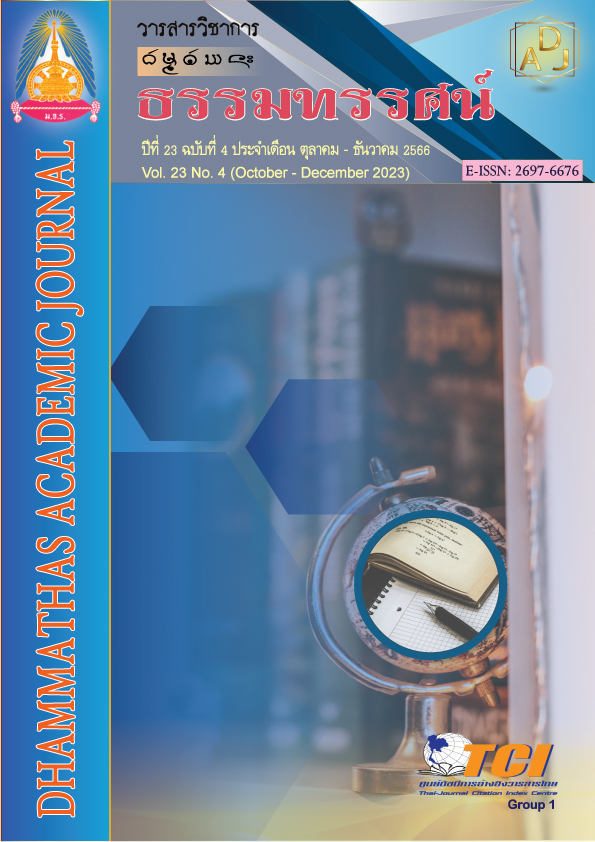The 'Rak-Na-Khwan' Ceremony in Buddhism
Main Article Content
Abstract
The 'Rak-Na-Khwan' ceremony in Buddhism: in India, before the Buddhist era, the Aryans originally were semi-nomadic herderswho began to settle down by farming and raising animals with various rituals to make sacrifices, worship, pray to the gods about crops such asthe god of earth, water, wind, fire, and other natures. In the Buddha's life, the way of life of the farmers was related to the traditions and culture of farming, which was the practice believed to produce complete food andbring good luck and security to life, property, and related things, such as the ceremony of worshiping the goddess, the ceremony to Kwan Mae Phosop, etc., which in the Pāli language is called the ceremony about planting rice or 'Royal VappmangalaCeremony'.
The 'Rak-Na-Khwan' ceremony in the Kasibhāradavāja Sutta: farming was one of the Sakya family's occupations during the Buddha's time. Most of the names were related to rice, such as (1) Suddhodana, (2) Totodana, and (3) Amittodana. The structure of the Kasibhāradavāja Sutta can be classified into five parts as follows: (1) individuals consist of Lord Buddha, Kasibhāradavāja Brahmins, and 500 Brahmins; (2) places include Brahmin villages named Eknāḷā and Dakkhiṇāgīrīrural in Magadha; (3) the Dhammas consist of Saddhā, Tapa, Hiri, Citta, Sati, Saṁvara, Soracca, and Viriya; (4) agriculture consists of crops, rain, yoke, plow, ropes, plows, and skewers, plucking grass, harvesting sickles, liberating plows and cattle; (5) the rituals consist of the 'Rak-Na-Khwan'ceremony, equipment, and attendees of the ceremony.
Article Details

This work is licensed under a Creative Commons Attribution-NonCommercial-NoDerivatives 4.0 International License.
เพื่อให้เป็นไปตามกฎหมายลิขสิทธิ์ ผู้นิพนธ์ทุกท่านต้องลงลายมือชื่อในแบบฟอร์มใบมอบลิขสิทธิ์บทความ ให้แก่วารสารฯ พร้อมกับบทความต้นฉบับที่ได้แก้ไขครั้งสุดท้าย นอกจากนี้ ผู้นิพนธ์ทุกท่านต้องยืนยันว่าบทความ ต้นฉบับที่ส่งมาตีพิมพ์นั้น ได้ส่งมาตีพิมพ์เฉพาะในวารสาร วิชาการธรรม ทรรศน์ เพียงแห่งเดียวเท่านั้น หากมีการใช้ ภาพหรือตารางของผู้นิพนธ์อื่นที่ปรากฏในสิ่งตีพิมพ์อื่นมาแล้ว ผู้นิพนธ์ต้องขออนุญาตเจ้าของลิขสิทธิ์ก่อน พร้อมทั้ง แสดงหนังสือที่ได้รับการยินยอมต่อบรรณาธิการ ก่อนที่บทความจะได้รับการตีพิมพ์References
กรมวิชาการเกษตร กระทรวงเกษตรและสหกรณ์. (2536). เกษตรยั่งยืน อนาคตการเกษตรไทย. กรุงเทพฯ: กรมวิชาการเกษตร.
กัณฐชา วิญญูวิริยวงศ์. (2559). พระพุทธศาสนาเพื่อสังคมแนวเกษตรกรรม. วารสารพุทธจิตวิทยา, 1(1), 79-94.
พระครูสถิตพัฒนาทร (ช่วง ฐิตโสภโณ). (2561). กสิภารทวาชสูตร: พุทธวิธีการสอนที่แยบคาย. วารสารบัณฑิตสาเกตปริทรรศน์, 3(2), 15-30.
มนูญ มุกข์ประดิษฐ์. (2548). การศึกษาวิเคราะห์ปรัชญาเศรษฐกิจพอเพียง อันเนื่องมาจากพระราชดำริ กับหลักธรรมในพระพุทธศาสนา. (วิทยานิพนธ์พุทธศาสตรดุษฎีบัณฑิต). พระนครศรีอยุธยา: มหาวิทยาลัยมหาจุฬาลงกรณราชวิทยาลัย.
มหาจุฬาลงกรณราชวิทยาลัย. (2539). พระไตรปิฎกภาษาไทย ฉบับมหาจุฬาลงกรณราชวิทยาลัย. กรุงเทพฯ: มหาจุฬาลงกรณราชวิทยาลัย.
สุนันท์ อยู่คงดี. (2559). พระราชพิธีจรดพระนังคัลแรกนาขวัญ. วารสารวิชาการศรีปทุม ชลบุรี, 1(13), 1-6.

